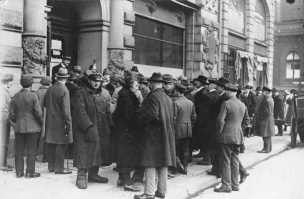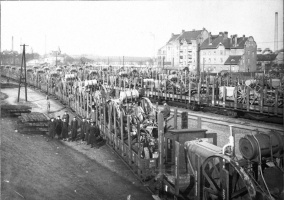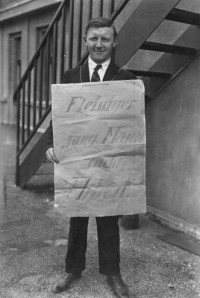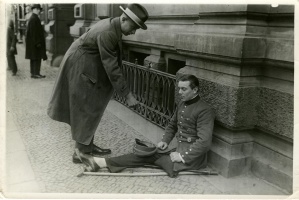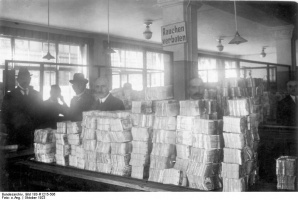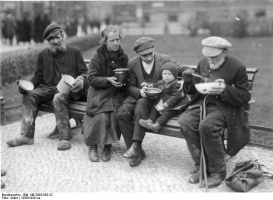Introduction↑
There are a lot of myths about the legacy of the Versailles Treaty. Germany’s territorial losses and the imposed reparations are the key words that not only came up in contemporary discussions, but are still mentioned today when considering the economic legacy of World War I. These high burdens on the German economy, as they were perceived at the time, resulted from the Treaty of Versailles. According to Article 231, Germany and its allies, as the sole aggressors, were responsible for all damages resulting from the war. They were obliged to pay reparations to their war opponents. The determination of the amount of this politically defined debt was entrusted to the inter-allied reparations commission.[1] In addition to the reimbursement of war costs in the narrower sense, this commission also negotiated damages such as the Allies’ state debts incurred by the issue of war bonds, or the pensions paid to war victims. Since Germany’s payment morale was poor, only small amounts were transferred in the 1920s. We will see later how the problem of reparations fits into the complexity of the economic burdens of war.
The territorial cessions as another political sanction of the Treaty of Versailles were opposed by a swelling circle of German nationalists. German production capacities were reduced by about 10 percent. In assessing the initial economic conditions, one must consider the low level of war destruction in German territory, but also the lack of investment during the war. Despite population losses in the millions, the war did not bring about a significant shift in German capital intensity, i.e. the per capita endowment with real capital. This consideration, however, seems more important than the absolute size of the national economy. The reduction in the state territory did not mean that the Germans had become poorer.[2]
The economic problems of the post-war period must be viewed in a more differentiated way than contemporaries did in their political arguments. First, the extent to which the war represented a structural break will be discussed (section 2). The war-induced deformation of the economic structure as well as the war-related shortages had a negative impact on production during the phase of demobilization (section 3). In order to achieve social pacification and to meet the economic expectations of the population, high wage settlements were politically supported, thus accepting the progression of inflation (section 4). The financial room for manoeuvre narrowed visibly with the onset of hyperinflation which also had a considerable impact on the real economy. The currency reform of 1923, conceived to save the state’s finances, depended on a change in the mode of reparations payment as well as on a reorientation of the foreign economy (section 5). The article ends with the mid-1920s, when the German economy entered a brief period of calm until the Great Depression hit the country with full strength.
The war as a structural break?↑
From which perspective should one consider the possibility of a structural break caused by the war? A revolutionary break, as expected and partly longed for by many contemporaries, did not occur. The war did not bring a crisis that led to the end of capitalist development, a secular stagnation, or a gradual slowing of the dynamics of technical and economic progress.[3] If long-term growth is chosen as the leitmotif for economic development in the 19th and 20th centuries, one can recognize many constants across the war. Despite deep cuts, a lot of growth-determining factors remained unchanged: Germany’s geographic and climatic location, the use of land, human capital, level of knowledge, mentality, volume of assets, communication networks, and significant parts of the legal system.[4]
Some scholarly debates on long-term economic development are explicitly based on the structural break thesis. This theory assumes that an economic system is replaced by another because of fundamental changes within the institutional framework. This view starts in the political sphere. The state took on a new role during the war and there was a clear modification of economic guidelines. This resulted in a radical change in the economic order and state policy. In Germany, this happened with an administrative upheaval through the establishment of a bureaucracy that took over economic control tasks. In the middle of the war, in August 1916, a “Reich Commissariat for transitional economics” (Reichskommissat für die Übergangswirtschaft) came into being, which had to prepare the peace economy after the armistice. The new Reich Economic Office within the Ministry of the Interior, established in 1917, aimed in the same direction.[5] Thus, the Reich had a civilian economic administration after the war. The expansion of such organizations also had personnel consequences. Practitioners from the business world now entered the state bureaucracy more frequently. Industrial entrepreneurs, who initially held transitional positions in the high ministerial bureaucracy during the war, were now more involved in economic policy decisions. The long-term effect was that regulatory interventions in the economic process became more frequent, as long as they were based on sound expertise.
Growth and production↑
Up to this point, we can state that World War I was a dramatic slump for the German economy, especially with regard to material production. In the first months of the war, mobilization led to a significant drop in production and employment and at the same time unemployment rose. This was mainly the result of an incorrectly implemented recruitment policy. Driven by the idea of a quick and short war, the decisions of the political and military leadership initially took little account of economic issues. Supply chains were broken and branches of production that were important for the armament industry, and also for consumers, were disrupted in their activities. In order to stabilize wartime production, an improvised control of raw material distribution was installed.[6] Industries that were not important to the war effort were combed out for labour, raw materials, and machinery. Their activities were increasingly curtailed and often the firms shut down completely. Because of this, production declined considerably.
Moreover, the Allied blockade had a severe and lasting effect on German food and raw material supply. Between 1915 and 1918, German imports and consumption-oriented production declined in parallel. Industrial production was also severely affected. By 1918, it had fallen to 57 percent of its 1913 value. In agriculture, the decline was most severe in the famine winter of 1916/17, when domestic production reached only 60 percent of the pre-war level.[7] This low level could no longer be increased until the end of the war. Germany was not alone with these poor figures; a similar picture emerged for the Habsburg Monarchy and the warring states of continental Europe as a whole. In contrast, the war brought a marked upswing both in the United States and Great Britain, despite the German attempt at a counter-blockade through submarine warfare.[8] Labour productivity also fell sharply during the war. This was mainly an effect of male workers being sent to the front and replaced by other workers – mostly women, but also forced laborers. The miserable supply led to a vicious cycle: the decline in production led to poor nutrition which reduced the ability to work. This led to a further downward movement in production.
These war effects give hints about the economic burdens that the newly founded German Republic had to bear. The first thing on the economic policy agenda was the elimination of the structural consequences of war. Above all, this meant fighting against hunger, reintegrating returning soldiers into the workforce, and converting war production to a peacetime economy. In quantitative terms, the economic results of the following years were moderate. In 1919, the GDP per capita was 73 percent of the 1913 level. It rose to 81 percent in 1923 and to 96 percent in 1925, and in 1927 it exceeded pre-war levels for the first time.[9] Thus, weak growth was characteristic of the entire post-war period. This was mainly a result of low investments and low profits despite rationalization efforts and poor capacity utilization due to the low export rate. These impairments affected the industrial sector in particular. German industrial production, which had fallen back to the level of the late 1880s by the end of the war, could only reach its pre-war level in 1927. Total labour productivity also remained at a low level until that year.[10] Even agricultural production grew only modestly: despite modernization, for instance the increasing use of artificial fertilizers or electricity, the pre-war level of yields per hectare could hardly be reached.[11] However, some of the weaknesses observed domestically were related to the unfavourable external economic relations. The overall weakness of growth in the world economy was due to the massive distortions in international markets and to global protectionism.
Wage policy and unemployment↑
Across Europe, the war reduced the repression of the labour movement. Workers’ representatives and trade unionists were recognized as equal negotiating partners. In Germany, too, the labour movement was able to achieve rapid social and socio-political successes after the end of the war. This was not so much related to the revolution since the implementation of far-reaching socialisation goals failed in early 1919. Rather, the negotiating successes were based on a corporatist social alliance that employers and trade unions formed shortly after the end of the war: the Zentralarbeitsgemeinschaft, the Central Working Community of the German commercial and industrial employers and leading trade unionists. Employers’ willingness to engage in this round of talks resulted from an about-face in their attitude because they feared the threat of revolution.[12] In a favourable climate, the trade unions were able to push through long-standing demands against the employers. As early as 15 November 1918, the labour market parties reached a contractual agreement on essential social issues. The most important achievement was the introduction of the eight-hour day, which meant a considerable reduction in the working week. The unions were keen to maintain weekly incomes and demanded significant wage increases. However, employers refused to meet the demand for full wage compensation.[13]
Another important innovation was the establishment of collective agreements on wage and working conditions. In practice, wage formation often proved difficult because the social peace invoked by the Central Working Community did not last long. The necessary agreement was often lacking, such that the Reich Office for Economic Demobilisation or, in important cases, the Reich Minister of Labour intervened in collective bargaining disputes. Thus, the state authorities were able to secure social peace through arbitration – but very often against the will of the bargaining parties. The result was a far-reaching state influence on the development of wage levels.
Collective wage formation in the post-war years initially led to clear redistribution effects in favour of the working class. Moreover, it got more difficult to cut wages during economic crises and this had a remarkable influence on the economic cycles of the 1920s. At an international level, this change became apparent in the sharp crises of the transition economies in the United States and Britain after the end of the war. Their attempts to face post-war deflation by restoring the gold parity of their currencies led to a rise in unemployment. Unlike in comparable historical cases, the general fall of prices was not accompanied by a reduction of wage costs that would have made the employment of workers profitable and gradually contribute to an economic recovery.[14]
This international experience did not initially apply to Germany, because it continued a path of inflation.[15] Currency stabilization failed until the monetary reform that followed the hyperinflation of 1923. The government adopted the tactic of an inflationary consensus by abandoning the goal of monetary stability, thus shifting to a political shaping of wages. The aim was to buy social stability in return for generous wage concessions; wage enforcement was made possible through the described means of state arbitration. The rise of nominal wages postponed the escalation of the wage conflict. While prices rose steadily, workers’ incomes remained rather stable because real hourly wages almost reached pre-war levels. However, the introduction of the eight-hour day meant that weekly wages, except for unskilled workers, were significantly lower than before the war. This was even more true for the salaries of civil servants and employees, whose relative losses were greater due to their initially higher income levels.
Unemployment in Germany remained at a low level from mid-1919 to the end of 1922. During the same period, industrial production roughly doubled and the GDP also increased, so that Germany was spared the 1921 economic collapse of other western industrialized countries. During the demobilization phase in Germany, state orders, subsidies, and public works provided an increase in the demand for labour, thus balancing the labour market.[16]
Hourly wages rose so sharply during the 1920s such that towards the end of the decade they were around 30 percent higher than in 1913 – taking into account the cost of living. This made labour considerably more expensive for industry without being compensated by higher growth rates. An intensive debate began about the negative consequences of too high wages.[17] As the daily working time was reduced to eight hours, the weekly wages which were relevant for personal incomes stagnated. Workers had to work less, but they also had lower earnings over a longer period of time. It was only in 1928 that real wages per week exceeded the pre-war level.
Public finance, reparations, and foreign trade↑
The tax reform of 1919/20, initiated and implemented by the Minister of Finance Matthias Erzberger (1875-1921), placed the state’s budget on a new foundation. In accordance with the Weimar Constitution, it centralized tax sovereignty and tax collection at the state level. The number of taxes which had to be paid to the Reich expanded considerably. A turnover tax and a standardized, highly progressive income tax were newly introduced, placing a heavier burden particularly on persons with high incomes. While the top income tax rate was 10 percent before the war, it now rose to 60 percent. The previously dominant taxes paid to the municipalities and federal states (Länder) played only a subordinate role in the new system. From then on, the Reich no longer bore the costs of the federal states, but the Länder were financially dependent on the Reich.[18] After an initial positive development, revenues, especially from income tax, collapsed and only recovered when hyperinflation ended. Fiercely opposed by the nationalist camp, the additional income from higher tax revenues were to be used for the reparation transfers in fulfilment of the Treaty of Versailles.
The Treaty of Versailles had left the exact amount of reparations undetermined. The transfers were initially to be paid according to the provisional annuities fixed by the Reparation Commission. While some transfers were levied as deliveries in kind, for example by sending coal, others were payable as monetary amounts in foreign currency. However, the extensive money transfers abroad posed a particular problem. Export surpluses were to be used to procure sufficient foreign currencies to manage the reparation transfer. On the one hand, the risk had to be countered that this transfer would cause German export prices to change too much in relation to those for imports. On the other hand, there was the risk that there would be no export surplus at all: any attempt to transfer money to the reparations account would attract an inflow of capital to Germany via the international capital markets. As a result, the reparations would be paid on credit and the real economic transfer would be close to zero. However, it can also be shown that the reparations created demand in the post-war depression and thus had a positive effect on production. Orders were placed with domestic industries and brought employment. After World War I, coal production in the Ruhr and Saar districts continued at a high level, encouraged by the obligation to deliver coal to France and Belgium.[19]
In the reparations-receiving countries, too, the private sector’s interest in the low-priced state imports was divided. As often in the interwar period, entrepreneurs demanded protective tariffs to prevent business from being affected by German competition. The protective tariffs were like a special tax on the German goods, but the price surcharge was not counted against reparations. This provided an incentive for the German government to undermine the foreign tariff systems by devaluing its own currency. This incentive was reinforced by the fact that the price level in the other European countries fell sharply when they tried to return to the gold standard. All these circumstances were a considerable burden on German exports.
In addition, the external devaluation of German notes was fueled by speculative transactions with short-term Reichsbank loans, e.g. discounted bills of exchange, which could be repaid after maturity in heavily devalued currency. The devaluation of the Mark was in turn accelerated by the late payment of taxes, taking advantage of generous deadlines for self-assessment of income tax. Maybe the political unwillingness of the administration to collect taxes for the benefit of the hated reparation creditors or even the hated Republic played an additional role.[20] The German government turned to the Reichsbank to finance its budget deficits, which it financed by issuing banknotes that rapidly rose to infinity.[21] Already in the first phase of the price rise in the second half of 1920, all savings accounts, such as life insurance policies and war bonds, were devalued. These were the typical investment forms of civil servants and employees. The impoverishment of these population groups increased their susceptibility to political radicalization.
The other side of this self-destruction of the German financial system was the further intensification of the reparation conflict. As a sanction against German coal deliveries in arrears, French and Belgian troops moved into the Ruhr region in January 1923 to force the fulfilment of the agreed quotas. In response, the Reich government called for passive resistance by halting industrial production.[22] In order to support the Ruhr population and to compensate for the resulting financial shortfalls, money printing was further accelerated. However, production now fell sharply, and Germany experienced a recession with raging inflation. In the end, banknotes were overstamped with increased denominations in the billions and then put back into circulation.
It was only possible to end the hyperinflation in November 1923 when an international agreement was reached on the temporary suspension of reparations. The United States government organized a stabilization plan for Germany, which included the granting of loans by American private banks.[23] The Reichsbank was internationalized and severe restrictions were imposed on the granting of loans for public expenditure. The Dawes Plan of August 1924 succeeded in postponing the payments for a few years. However, the reparations problem remained unsolved and its solution was further complicated by the wave of foreign loans which were now pouring into the country and would have to be repaid in the future. In the period between 1924 and 1929, known as the “Golden Twenties,” Germany experienced relative economic and political stabilization.[24]
Conclusion↑
Economic reconstruction after World War I remained incomplete. The economic depression during the war was followed by a brief upswing which lasted until the Ruhr occupation and hyperinflation. Even in the “Golden Twenties” after the currency reform, there were still signs of crisis: the number of company bankruptcies reached a peak after the collapse of the inflationary consensus. Unemployment rose to an unprecedented level of 10 percent by 1926, so that an interventionist economic policy was pursued.[25] When recovery began in 1927, it was interrupted a short time later by the outbreak of the Great Depression in 1929. At no point was the economy of the first German republic able to return to the historical trends in productivity and per capita income that had been set by steady growth up to 1914. World War I did not set an economic dynamic in motion but marked the beginning of a long-lasting period of economic weakness. After the National Socialist upswing, which was based almost exclusively on an armament boom and culminated in the devastating World War II, this weakness was not fully overcome until the 1970s.
Marcel Boldorf, Université Lumière Lyon 2
Section Editor: Markus Pöhlmann
Notes
- ↑ See Tooze, Adam: The Deluge. The Great War and the Remaking of Global Order, 1916–1931, London 2014, pp. 288-304.
- ↑ See Spoerer, Mark / Streb, Jochen: Neue deutsche Wirtschaftsgeschichte des 20. Jahrhunderts, Munich 2013, p. 74.
- ↑ Ritschl, Albrecht: Wirtschaftliche Folgen des Erstens Weltkriegs, in: Boldorf, Marcel (ed.): Deutsche Wirtschaft im Ersten Weltkrieg (Handbücher zur Wirtschaftsgeschichte), Berlin/Boston 2020, pp. 613-615.
- ↑ Borchardt, Knut: Wachstum, Krisen, Handlungsspielräume der Wirtschaftspolitik. Studien zur Wirtschaftsgeschichte des 19. und 20. Jahrhunderts, Göttingen 1982, p. 114.
- ↑ Fisch, Stefan: Strukturwandel vom Reichswirtschaftsamt und Reichswirtschaftsministerium im Übergang zur Weimarer Republik, in: Holtfrerich, Carl-Ludwig (ed.): Das Reichswirtschaftsministerium der Weimarer Republik und seine Vorläufer. Strukturen, Akteure, Handlungsfelder. Berlin/Boston 2016, p. 96-145.
- ↑ Boldorf, Marcel: Ordnungspolitik und wirtschaftliche Lenkung, in: Boldorf, Deutsche Wirtschaft im Ersten Weltkrieg 2020, pp. 23-66.
- ↑ Ritschl, Albrecht: The Pity of Peace: Germany's War Economy, 1914–1918 and Beyond, in: Broadberry, Stephen / Harrison, Mark (eds.): The Economics of World War I, Cambridge 2005, p. 46.
- ↑ Cf. Broadberry, Stephen / Howlett, Peter: The United Kingdom During World War I: Business as Usual?, in: Broadberry / Harrison, The Economics of World War I 2005, pp. 206-234.
- ↑ Ritschl, Albrecht / Spoerer, Mark: Das Bruttosozialprodukt in Deutschland nach den amtlichen Volkseinkommens- und Sozialproduktstatistiken 1901–1995, in: Jahrbuch für Wirtschaftsgeschichte 2 (1997), p. 51.
- ↑ Ritschl, Albrecht: Zu hohe Löhne in der Weimarer Republik? Eine Auseinandersetzung mit Holtfrerichs Berechnungen zur Lohnposition der Arbeiterschaft 1925–1932, in: Geschichte und Gesellschaft 16 (1990), pp. 397ff.
- ↑ Kopsidis, Michael: Landwirtschaft, in: Rahlf, Thomas (ed.): Deutschland in Daten. Zeitreihen zur Historischen Statistik, Bonn 2015, p. 239.
- ↑ Kocka, Jürgen: Facing Total War: German Society, 1914–1918, Cambridge 1984.
- ↑ Feldman, Gerald D.: Army, Industry and Labor in Germany, 1914–1918, Princeton 1966, p. 521.
- ↑ See Eichengreen, Barry J.: Golden Fetters. The Gold Standard and the Great Depression, 1919–1939, Oxford 1992, pp. 203-207.
- ↑ This is the key finding of Holtfrerich, Carl-Ludwig: The German Inflation 1914–1923. Causes and Effects in International Perspective, Berlin 1986.
- ↑ Boldorf, Marcel: Deutsche Wirtschaft und Politik. Vom Kaiserreich bis ins 21. Jahrhundert, Darmstadt 2018, p. 47.
- ↑ Starting with the initial thesis of Borchardt, Wachstum, Krisen, Handlungsspielräume 1982, pp. 165-182.
- ↑ Ullmann, Hans-Peter: Der deutsche Steuerstaat. Geschichte der öffentlichen Finanzen vom 18. Jahrhundert bis heute, Munich 2005, pp. 101-103.
- ↑ See also for the following paragraphs, Ritschl, Wirtschaftliche Folgen 2020, pp. 609-611.
- ↑ See on the “politics of fulfillment,” Feldman, Gerald D.: The Great Disorder. Politics, Economics, and Society in the German Inflation, 1914–1924, Oxford/New York 1993, pp. 344-384.
- ↑ Webb, Steven: Hyperinflation and Stabilization in Weimar Germany, Oxford 1989.
- ↑ Fischer, Conan: The Ruhr Crisis, 1923–1924, Oxford 2003; Tooze, The Deluge 2014, pp. 443-445.
- ↑ Tooze, The Deluge 2014, pp. 452-461.
- ↑ Ritschl, Albrecht / Straumann, Tobias: Business Cycles and Economic Policy, 1914–1945, in: Broadberry, Stephen / O’Rourke, Revin (eds.): The Cambridge Economic History of Modern Europe, vol. 2: 1870 to the Present, Cambridge 2010, p. 177.
- ↑ Boldorf, Deutsche Wirtschaft und Politik 2020, pp. 51-53. In more detail: Hertz-Eichenrode, Dieter: Wirtschaftskrise und Arbeitsbeschaffung. Konjunkturpolitik 1925/26 und die Grundlagen der Krisenpolitik Brünings, Frankfurt 1982.
Selected Bibliography
- Balderston, Theo: Economics and politics in the Weimar Republic, Cambridge 2002: Cambridge University Press.
- Blaich, Fritz: Der Schwarze Freitag. Inflation und Wirtschaftskrise, München 1994: Deutscher Taschenbuch Verlag.
- Boldorf, Marcel: Ordnungspolitik und wirtschaftliche Lenkung, in: Boldorf, Marcel (ed.): Deutsche Wirtschaft im Ersten Weltkrieg, Berlin; Boston 2020: De Gruyter Oldenbourg, pp. 23–66.
- Broadberry, Stephen; Ritschl, Albrecht: Real wages, productivity, and unemployment in Britain and Germany during the 1920's, in: Explorations in Economic History 32/3, 1995, pp. 327-349.
- Eichengreen, Barry J.: Golden fetters. The gold standard and the Great Depression, 1919-1939, New York 1995: Oxford University Press.
- Feldman, Gerald D.: The great disorder. Politics, economics, and society in the German inflation, 1914-1924, New York 1993: Oxford University Press.
- Fischer, Conan: The Ruhr crisis, 1923-1924, Oxford; New York 2003: Oxford University Press.
- Hertz-Eichenrode, Dieter: Wirtschaftskrise und Arbeitsbeschaffung. Konjunkturpolitik 1925/26 und die Grundlagen der Krisenpolitik Brünings, Frankfurt/Main [u.a. 1982: Campus-Verl..
- Holtfrerich, Carl-Ludwig: The German inflation, 1914-1923. Causes and effects in international perspective, New York 1986.
- Holtfrerich, Carl-Ludwig (ed.): Das Reichswirtschaftsministerium der Weimarer Republik und seine Vorläufer. Strukturen, Akteure, Handlungsfelder (Wirtschaftspolitik in Deutschland 1917–1990, volume 1), Berlin 2016: De Gruyter Oldenbourg.
- James, Harold: The German Slump. Politics and Economics, 1924-1936, Oxford 1986: Clarendon Press.
- Petzina, Dietmar: Die deutsche Wirtschaft in der Zwischenkriegszeit, Wiesbaden 1977: Steiner.
- Ritschl, Albrecht: Zu hohe Löhne in der Weimarer Republik? Eine Auseinandersetzung mit Holtfrerichs Berechnungen zur Lohnposition der Arbeiterschaft 1925–1932, in: Geschichte und Gesellschaft 16, 1990, pp. 375-402.
- Ritschl, Albrecht: Wirtschaftliche Folgen des Ersten Weltkriegs, in: Boldorf, Marcel (ed.): Deutsche Wirtschaft im Ersten Weltkrieg, Berlin; Boston 2020: De Gruyter Oldenbourg, pp. 601-618.
- Ritschl, Albrecht: The pity of peace. Germany’s economy at war, 1914-1918 and beyond, in: Broadberry, Stephen N. / Harrison, Mark (eds.): The economics of World War I, Cambridge; New York 2005: Cambridge University Press, pp. 41-76.
- Ullmann, Hans-Peter: Der Deutsche Steuerstaat. Geschichte der öffentlichen Finanzen vom 18. Jahrhundert bis heute, München 2005: C. H. Beck.
- Webb, Steven Benjamin: Hyperinflation and stabilization in Weimar Germany, Oxford 1989: Oxford University Press.





